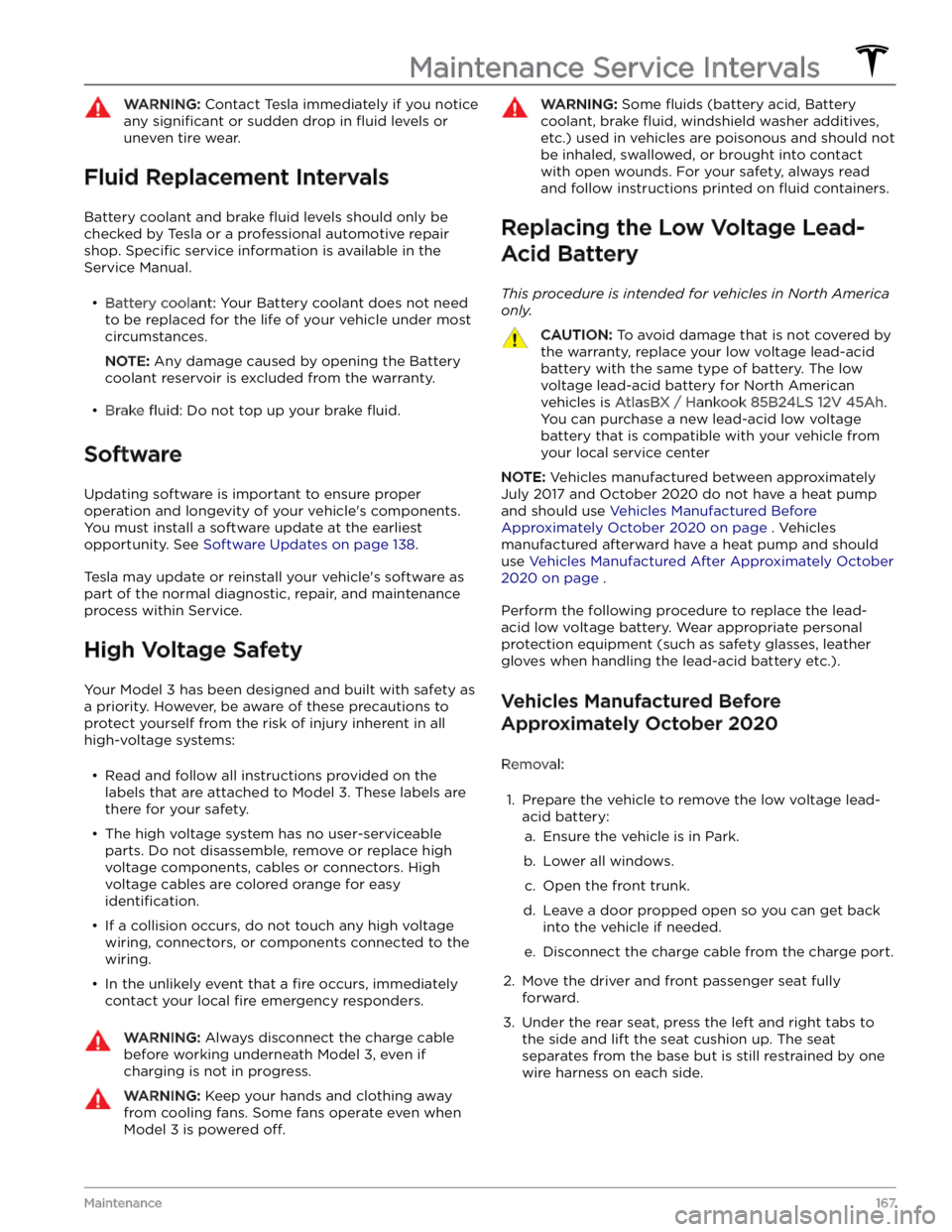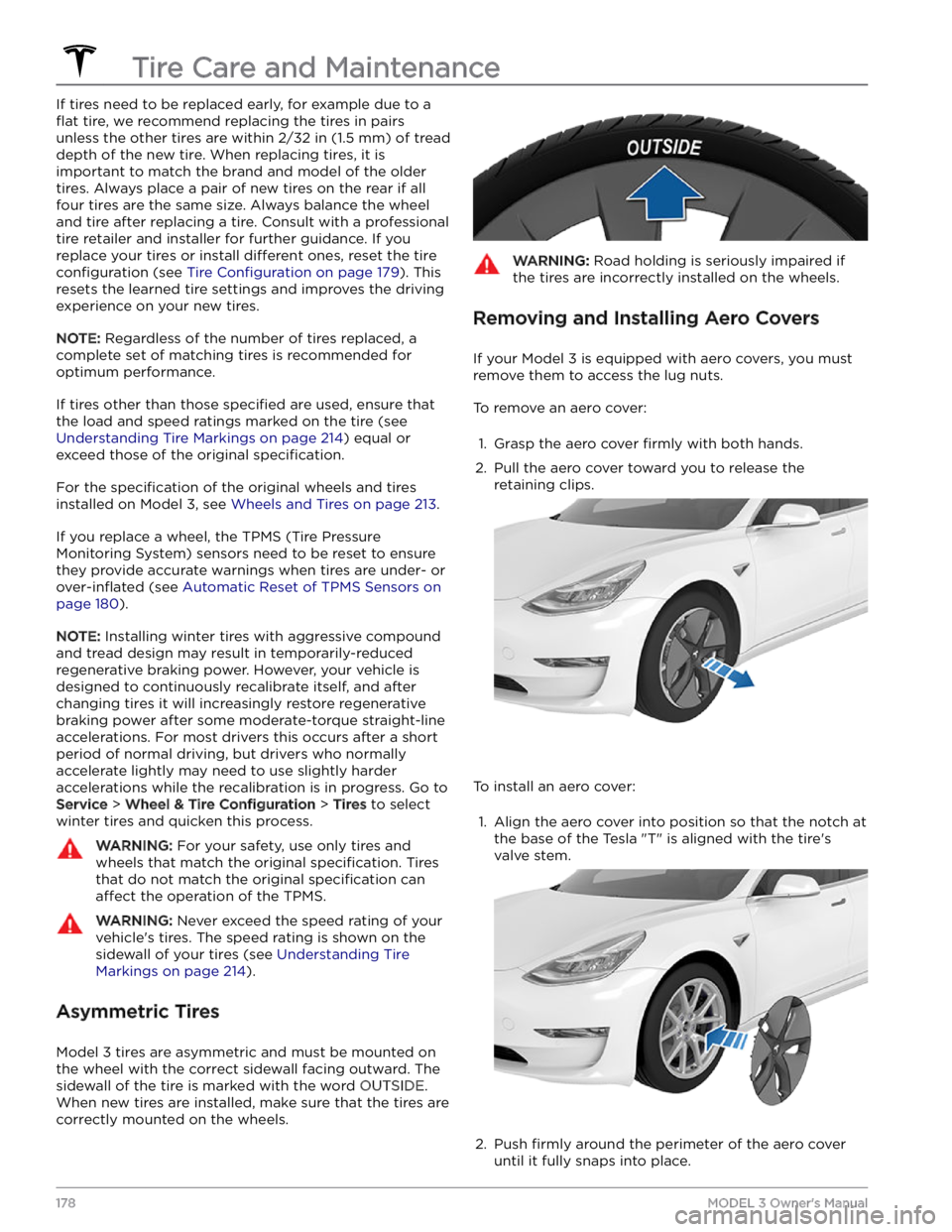service TESLA MODEL 3 2023 User Guide
[x] Cancel search | Manufacturer: TESLA, Model Year: 2023, Model line: MODEL 3, Model: TESLA MODEL 3 2023Pages: 296, PDF Size: 9.84 MB
Page 164 of 296

WARNING: Do not perform this procedure when
your vehicle is charging, or if any orange high
voltage conductors are exposed. Failure to follow
these instructions can result in electric shock and
serious injury or damage to the vehicle. If you are
uncertain as to how to safely perform this
procedure, contact your nearest Service Center.
Charging Instructions
162MODEL 3 Owner
Page 168 of 296

Service Intervals
Your vehicle should generally be serviced on an as-needed basis. However, Tesla recommends the following maintenance items and intervals, as applicable to your
vehicle, to ensure continued reliability and
efficiency of
your
Model 3.
For more do-it-yourself maintenance procedures and information, see
https://www.tesla.com/support/do-it-
yourself-guides.
For more information on vehicle alerts, see
Troubleshooting Alerts on page 227.
Page 169 of 296

WARNING: Contact Tesla immediately if you notice
any significant or sudden drop in fluid levels or
uneven tire wear.
Fluid Replacement Intervals
Battery coolant and brake fluid levels should only be
checked by
Tesla or a professional automotive repair
shop. Specific service information is available in the
Service Manual.
Page 171 of 296

WARNING: The area under the seat cushion
houses the high voltage Battery. DO NOT
TOUCH OR PLACE ITEMS ON THE METAL
HOUSING! Doing so can cause serious damage
or injury.
9.
With a 10mm socket, loosen the nut that secures the negative (-) terminal clamp to the negative (-) post on the low voltage lead-acid battery. Release the terminal clamp from the negative (-) post.
10.
With a 10mm socket, release the terminal cover and loosen the nut that secures the positive (+) terminal
clamp to the positive (+) post on the low voltage
lead-acid battery. Release the terminal clamp from the positive (+) post and cover the terminal clamp with a dry rag.
CAUTION: Do not allow the positive (+)
terminal clamp to contact nearby components
like the low voltage battery hold down bracket
or A/C cooling lines.
11.
Unplug the vent tube hose from the negative (-)
terminal side of the low voltage lead-acid battery.
12.
With a 10mm socket, loosen the nut and release the
battery hold down from the top of the low voltage
lead-acid battery by unhooking and sliding it back, taking care to ensure it does not slip into the vehicle.
13.
Using the battery handle, carefully remove the low
voltage lead-acid battery, taking care not to touch or damage the surrounding components.
WARNING: When lifting the low voltage lead-
acid battery, stand in front of the vehicle and
use proper lifting technique. The low voltage
battery weighs approximately 25 lb (12 kg).
Failure to do so may cause serious injury.Maintenance Service Intervals
169Maintenance
Page 172 of 296

14.
Inspect the new low voltage lead-acid battery to ensure it is equipped a red plug on the positive (+) terminal side. If the new low voltage battery does not have a red plug, use a small trim tool transfer the red plug from the old battery to the new one.
CAUTION: Dispose of the old low voltage lead-
acid battery according to local laws, such as
dropping it off at a battery recycling facility.
Keep the low voltage battery upright and place
it on a towel or piece of cardboard when
transporting it.
Installation:
1.
Remove the protective caps from the positive (+) and negative (-) posts on new low voltage lead-acid
battery.
2.
Carefully maneuver the new low voltage battery into place, taking care not to touch or damage nearby
components.
3. Install the low voltage battery hold down and use a
10mm socket to tighten the bolt that secures it to the low voltage lead-acid battery. Torque the bolt to 6
Nm (4.4 ft-lb).4.
In the rear passenger seat, connect the penthouse cable to the connector:
a.
Ensure the gray lever-arm is down, then install the
connector.
b.
Secure the connector by gently tugging the gray
lever-arm upward until it clicks into place.
c.
Replace the foam cover on top of the penthouse cable.
Maintenance Service Intervals
170MODEL 3 Owner
Page 175 of 296

7.
With a 10mm socket, release the terminal cover and loosen the nut that secures the positive (+) terminal
clamp to the positive (+) post on the low voltage
lead-acid battery. Release the terminal clamp from the positive (+) post and cover the terminal clamp with a dry rag.
CAUTION: Do not allow the positive (+)
terminal clamp to contact nearby components
like the low voltage lead-acid battery hold
down bracket or A/C cooling lines.
8.
Unplug the vent tube hose from the negative (-)
terminal side of the low voltage battery.
9. With a 10mm socket, loosen the nut and release the
battery hold down from the top of the low voltage
lead-acid battery by unhooking and slipping it back. If needed, tilt the battery hold down backward so it does not slip into the vehicle.10.
Carefully remove the low voltage lead-acid battery,
taking care not to damage the surrounding components.
WARNING: When lifting the lead-acid battery,
stand in front of the vehicle and use proper
lifting technique. The lead-acid battery weighs
approximately 25 lb (12 kg). Failure to do so
may cause serious injury.
11.
Inspect the new low voltage lead-acid battery to make sure it is equipped with a red plug on the
positive (+) terminal side. If the new lead-acid battery does not have a red plug, transfer the red plug from
the old battery to the new one.
CAUTION: Dispose of the old low voltage lead-
acid battery according to local laws, such as
dropping it off at a battery recycling facility.
Keep the battery upright and place it on a towel
or piece of cardboard when transporting it.Maintenance Service Intervals
173Maintenance
Page 176 of 296

Installation:
1.
Remove the protective caps from the positive (+) and negative (-) posts on the new low voltage lead-acid battery.
2.
Carefully place the new lead-acid battery in the vehicle, taking care not to damage nearby
components.
3.
Install the low voltage lead-acid battery hold down
and use a 10mm socket to tighten the nut that secures it to the battery. Torque the nut to 6 Nm (4.4
ft-lb).
4.
Reconnect the first responder loop.
5.
Reconnect the positive (+) terminal by positioning
the terminal clamp over the terminal post. Using a 10mm socket, torque the nut to 6 Nm (4.4 ft-lb). Reinstall the positive (+) terminal cover.
6.
Reconnect the negative (-) terminal by positioning
the terminal clamp over the connector. Using a 10mm socket, torque the nut to 6 Nm (4.4 ft-lb).
7.
Connect the vent tube hose into the negative (-) terminal side of the low voltage lead-acid battery.
Maintenance Service Intervals
174MODEL 3 Owner
Page 178 of 296

Displaying Tire Pressures
Tire pressures display on the touchscreen in the cards
area on the car status display, or by touching Controls >
Service. The pressure of each tire displays in the
visualization of your
Model 3, in addition to what time
your tire pressures were last measured. You can choose
whether you want to display tire pressures using Bar or PSI by touching
Controls > Display > Tire Pressure. The
touchscreen also displays your vehicle
Page 180 of 296

If tires need to be replaced early, for example due to a
flat tire, we recommend replacing the tires in pairs
unless the other tires are within
2/32 in (1.5 mm) of tread
depth of the new tire. When replacing tires, it is important to match the brand and model of the older
tires. Always place a pair of new tires on the rear if all four tires are the same size. Always balance the wheel and tire after replacing a tire. Consult with a professional tire retailer and installer for further guidance.
If you
replace your tires or install different ones, reset the tire
configuration (see Tire Configuration on page 179). This
resets the learned tire settings and improves the driving
experience on your new tires.
NOTE: Regardless of the number of tires replaced, a
complete set of matching tires is recommended for optimum performance.
If tires other than those specified are used, ensure that
the load and speed ratings marked on the tire
(see
Understanding Tire Markings on page 214) equal or
exceed those of the original
specification.
For the specification of the original wheels and tires
installed on
Model 3, see Wheels and Tires on page 213.
If you replace a wheel, the TPMS (Tire Pressure Monitoring System) sensors need to be reset to ensure they provide accurate warnings when tires are under-
or
over-inflated (see Automatic Reset of TPMS Sensors on
page 180).
NOTE: Installing winter tires with aggressive compound
and tread design may result in temporarily-reduced regenerative braking power. However, your vehicle is
designed to continuously recalibrate itself, and after changing tires it will increasingly restore regenerative
braking power after some moderate-torque straight-line accelerations. For most drivers this occurs after a short period of normal driving, but drivers who normally
accelerate lightly may need to use slightly harder accelerations while the recalibration is in progress. Go to
Service > Wheel & Tire Configuration > Tires to select
winter tires and quicken this process.
WARNING: For your safety, use only tires and
wheels that match the original specification. Tires
that do not match the original specification can
affect the operation of the TPMS.
WARNING: Never exceed the speed rating of your
vehicle
Page 190 of 296

3. Lift the wiper arm a short distance away from the windshield, just far enough to access the wiper blade.CAUTION: Wiper blades do not lock into a lifted
position. Do not lift a wiper arm beyond its
intended position.
4.
Place a towel between the wiper arm and windshield to avoid scratching or cracking the windshield.
5.
Hold the wiper arm and press the locking tab while sliding the blade down the arm.
6.
Align the new wiper blade on the wiper arm and slide
it toward the end of the wiper arm until it locks into place.
7.
Turn Wiper Service Mode off to return the wipers to
their normal position.
Cleaning Washer Jets
If a windshield washer becomes blocked, use a thin
strand of wire to clear any blockages from the nozzles.
WARNING: Do not operate the washers while
cleaning Model 3. Windshield washer fluid can
irritate eyes and skin. Read and observe the
washer fluid manufacturer